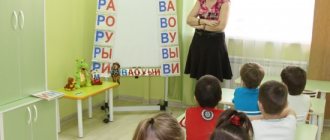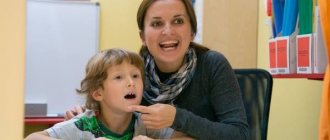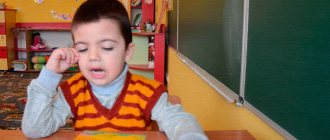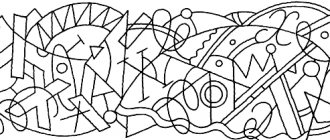Main types of speech disorders
Pathologies may affect spoken or written language. In each of these types, a number of deviations are noted.
Oral speech
Defects in the external design of speech include:
- dysphonia – absence of phonation (voice) or disturbance of its strength, pitch, timbre;
- bradyllalia - a significant slowdown in the rate of speech;
- tachylalia - accelerated rate of speech;
- tachyphrasia - fast speech, verbosity;
- stuttering – repetition of sounds, syllables, sudden stops when speaking due to spasms in the muscles of the speech apparatus;
- dyslalia - incorrect pronunciation, replacement of some sounds with others;
- rhinolalia (nasality) – disturbance of voice timbre and sound pronunciation;
- dysarthria – difficulty pronouncing certain sounds and words;
- anarthria - absence of the sound part of speech.
The group of pathologies associated with the structural-semantic formation of utterances includes:
- alalia – underdevelopment of speech while maintaining hearing and intelligence;
- aphasia is loss of speech as a result of diseases and injuries of the brain after it has been formed.
Letter
Violations of this type appear at school age, at the beginning of educational activities. These include:
- dyslexia is a reading disorder. The student does not recognize letters, cannot combine them into syllables, and syllables into words, and does not understand the text read;
- Dysgraphia is a writing disorder. The child does not remember the images of letters, misses them when writing words, and incorrectly formulates and writes sentences.
- alexia and agraphia – a child’s inability to master reading and writing skills. A combination of these disorders is often observed.
Before making a diagnosis, the speech therapist conducts diagnostics. If necessary, writes out a referral for consultation with a neurologist, neurosurgeon, or psychologist.
Where might a characteristic be needed?
Why do you need to prepare a testimonial for an eighth-grader? Why does a student even need this document?
This is also important to know:
Characteristics of a 4th grade student
In fact, characterization is necessary in a number of cases.
For example, a characterization is needed when the question of which parent the child will remain with after a divorce is decided through the court.
This document may be requested by the guardianship and trusteeship authorities if they consider that the parents are not paying enough attention to their child.
Another reason that suggests the need for such a document as a child’s characteristics is a request from the police.
And, finally, characterization is very necessary when it comes to transferring from one class to another. As you know, the ninth grade is graduation, that is, upon completion, the child ends up in high school.
This means that teachers must understand what kind of child they are dealing with, and most importantly, how to approach him correctly.
Diagnostic stages
At the initial stage, the specialist establishes contact with the child and collects anamnesis from the parents (birth characteristics, presence of chronic diseases). Reveals the level of general development (physical, mental), the state of the emotional-volitional sphere.
At the next stage, relationships with peers and adults, the nature of speech behavior, the ability to establish communication connections, and the student’s attitude towards his speech defect are studied.
Then the speech pathology is directly examined, a speech card is filled out, and a detailed description of the child is compiled.
Characteristic
Let's look at an example of how a pedagogical characteristic for an 8th grade student should be drawn up, what main points it should contain in order to be suitable. The documents are compiled based on materials from existing practicing teachers.
Example
Ivan Ivanov, born November 26, 2003, lives at the address Saratov, Lesnaya street, building 4, has been studying at school number 35 since the 1st grade.
Throughout his studies, he managed to establish himself as a very disciplined and diligent boy. He is distinguished by his special diligence, as well as his attentiveness to requests and details.
Throughout his time, he showed excellent results in humanities subjects and good grades in exact sciences.
Has a penchant for studying history, social studies and literature. He studies to the fullest extent of his abilities, expresses himself in every possible way in the lessons. To teachers, he demonstrates full interest in his studies, which indicates his hard work.
Has good auditory and visual memory. It works very quickly, but at the same time efficiently. Can master educational material well in a short time.
He has a broad outlook, as well as well-spoken and developed speech with a rich vocabulary.
He has proven himself well in relationships with classmates and has leadership qualities. Always interested in communication, ready to make friends and has many friends both in class and outside of it. Always ready to help.
Often takes responsibility for performing public tasks. He does it carefully, accurately, conscientiously. He was elected president of the school council. At the same time, he takes an active part in the social life of his class and school. On the day of self-government he held the position of director. He has also proven himself well in sports life, as he is a member of the basketball team.
He took part in the city Olympiad in history, where he took third place. Awarded a certificate of honor.
Always follows the rules of behavior established by the school and tries not to break them.
As for the composition of the family, the young man grows up in a complete family. Parents devote a lot of time to raising their children. They actively check his homework and take him to extracurricular swimming and basketball activities. They also spend their free time with him, visiting exhibitions, museums and cinema.
Parents take a special interest in their child’s life at school. Frequently attend parent-teacher conferences, periodically contact the class teacher, and respond positively to recommendations from teachers.
The young man is in good physical fitness and health. Has strong immunity. Plays basketball professionally. He is careful with his things and is used to keeping them in perfect order.
By nature, the young man is very modest, but at the same time reasonable, independent and disciplined. Friendly and responsive towards others. Very active and lively in conversation.
He is respected not only by his peers, but also by his teachers.
If criticism has been leveled at him, he will always listen to it fairly and react appropriately. Differs in balance and prudence. Even if he does something wrong, he is prone to introspection and criticism, therefore he is adequate in communication.
We can conclude that the child is emotionally stable, has time to study according to the program, and has stable moral and ethical principles. This means that he can be transferred to the ninth grade, where he will also definitely show himself on the positive side.
Memo on drawing up a speech therapy profile for a child
First, the speech therapist makes a brief history of the speech development of a small patient. Such an anamnesis is compiled after studying medical documentation and talking with parents (legal guardians).
Formulations:
- speech development without features;
- according to age;
- delayed speech development;
- started talking late;
- For a long time, it was difficult for others to understand what the child was saying.
Next, the speech environment and social conditions are assessed. The speech therapist can specify the following parameters:
- use of two languages for conversation in the family where the child lives;
- the speech environment is normal - without features;
- social conditions are unfavorable or favorable;
- one of the biological parents has or previously had problems with speech development;
- Direct relatives have no problems with pronunciation and never have had them.
The next stage involves assessing the child’s gross and fine motor skills. The speech therapist carefully studies the baby, how he works with his hands. Based on this, he can determine whether his motor skills are impaired or not, which hand is dominant, whether he holds the object for writing correctly or not, how soon he stops writing due to fatigue.
In addition to these parameters, the speech therapist also evaluates:
- articulatory apparatus (structure, movements, presence of anomalies);
- how the child’s speech sounds – is it impaired or not, does he clearly pronounce sounds, syllables, words or not. Also pay attention to intonation;
- speech understanding;
- active dictionary - how many words he knows, whether he understands their designation, which ones he uses most often during a conversation;
- grammatical structure;
- syllable structure;
- pronunciation of sounds;
- auditory perception of sounds;
- whether the child has coherent speech or not;
- writing and reading.
Example of a positive testimonial
It’s a completely different matter to write a positive reference for a child. Indeed, if a child studies well, behaves diligently, and has proven himself well in the learning process, then writing about him is a pleasure. In addition, we can note a lot of different factors that will help the child open up to other teachers in the future.
This is also important to know:
Psychological and pedagogical characteristics of 1st grade
What should be in the foreground in a positive characteristic of a child?
- First, you need to note in which subjects the student excels. This is very important, since teachers can reveal his talents in the future, without focusing on unnecessary subjects.
- The second important point is to describe the child’s character traits, because in order to reveal the full range of his knowledge and skills, it will be necessary to adapt to his character. Well, let’s look at what a correctly compiled positive reference for an 8th grade student should look like.
Example
Novak Victoria Aleksandrovna studies at Municipal Educational Institution Secondary School No. 18 in the city of Ryazan. Training is conducted from the first grade. Over all the years of study, she has proven herself to be a sociable and, most importantly, active student. She has a high intellectual level and a huge thirst for knowledge. The child does well in demonstrating his knowledge and skills in several academic disciplines. In addition, he shows great interest in the exact sciences, as well as physics and chemistry.
At the same time, after school he attends English lessons and a swimming section.
The girl has a very broad outlook. She notes that she likes to read in the evenings. He has his own opinion and always defends it in class. Formulates his thoughts well and competently.
Always attentive to the activity being performed, diligent and not distracted.
However, if the task requires it, he can quickly switch to another activity.
He masters the curriculum quickly, so he is slightly ahead of his peers.
Easily reproduces all knowledge acquired in lessons.
Always responsibly, accurately and correctly completes homework. He does his homework under the supervision of his mother, but has all the qualities for good self-discipline.
Always follows school rules. Doesn't miss lessons without special reasons.
Currently he is an assistant to the school president, which indicates a high level of responsibility.
The child is proactive and always offers interesting options for extracurricular activities. Participates in school-wide events. He has a good voice, so he often participates in city and regional shows of young talents.
The girl can be called hardworking, as she always takes an active part in community cleanups. Always in a good mood. The child is very honest and can achieve positive results in any activity he undertakes. Shows leadership qualities, and this allows her to take leading roles in the team of students.
Currently she is an athlete and is part of a dance group. The presence of bad habits has not been established.
Parents approach the upbringing of their child very responsibly. Attend parent-teacher conferences and visit school frequently as required by the teacher.
Example 2
Characteristics of the average 9th grade student
Characteristics of a 9th grade student Full name of student: XXX XXX year of birth, living at address: XXX
XXX has been studying at the educational institution since the 1st grade.
Physically healthy, active in physical education lessons. I attended the football section.
I mastered the program at an intermediate level. At the same time, XXX is a diligent student who made efforts to achieve results. Difficulties arose due to insufficiently developed abstract, figurative thinking and memory.
The graduate lives in a single-parent family with her mother and brother. Her mother provides her with everything necessary for successful education, but practically does not attend school and has little control over the student.
XXX is calm and does not enter into conflicts with anyone. Doesn't aspire to be a leader. She has a small circle of best friends with whom she mostly communicates.
The attitude towards work is positive. Diligently carries out instructions from teachers.
XXX is a modest, tactful, sympathetic girl.
Director
Classroom teacher
More documents from the pedagogy category:
If students have problems with sound pronunciation, individual-subgroup work is carried out according to the generally accepted scheme using speech material adapted for a given age.
The following character traits predominate: fairness, tact, responsiveness. Always had his own point of view. In the class he enjoyed authority among the students. He took part in the social life of the class and school. He always handled assignments conscientiously.
M. participates in all extracurricular activities and socially useful activities. She does not remain indifferent to everything that happens in the classroom and school.
Vladimir is characterized by such qualities as determination, independence and activity. Temperament is defined as sanguine (60%) and choleric. This explains the student’s ability to work, but at the same time the boy is unstable in his hobbies and often changes his areas of interest. Vladimir’s positive qualities, of course, include optimism, energy, responsiveness, and perseverance.
Organizational aspects
The document can be drawn up for the personal file of a 9th grade graduate. This characteristic can be provided to an educational institution of the highest level of accreditation when submitting documents for admission, as well as to the guardianship authorities, the military registration and enlistment office, and the police.
Traditionally, ready-made characteristics of 9th grade students are compiled by the class teacher. This work can be performed by the director or head teacher.
The data is presented in a free style. The maximum volume of psychological and pedagogical characteristics is not limited in any way. In the standard case, the information takes up an A4 sheet.
Psychological and pedagogical characteristics of junior schoolchildren with and general speech underdevelopment
Until relatively recently, sound pronunciation disorders were most often considered as an independent speech defect, not associated with the state of the child’s speech as a whole. Only the possibility of sound substitutions being reflected in writing in the form of corresponding letter substitutions was noted. And although the same children often had a poor vocabulary and the presence of agrammatisms in oral speech, all these symptoms were recorded separately and were not linked into a single picture of the general lag in the child’s speech development, into a picture of a violation of the normal course of this development.
In the 60s of the 20th century, due to a sharp increase in the number of speech pathologies in children, all individual manifestations of speech underdevelopment were united for the first time and their deep organic connection with each other was shown. This is reflected in the works of many scientists: R. E. Levin, R. M. Boskis, N. X. Shvachkin, L. F. Chistovich, A. R. Luria, L. F. Spirova, N.A. Nikashina, G.A. Kashe, A.V. Yastrebova, T.B. Filicheva, G.V. Chirkina, T.V. Tumanova and others.
The term “general speech underdevelopment” became firmly established in speech therapy only in the 60s, when a clearly expressed general delay in speech development began to be observed in many children. The underdevelopment of speech in children was called “general” for the reason that in such cases all its main aspects are underdeveloped or impaired. R.E. Levin gives the following definition: the general underdevelopment of speech in children with normal hearing and primary intact intelligence should be understood as a form of speech anomaly in which the formation of all components of the speech system, related to both the sound and semantic aspects of speech, is impaired.
This means that children with normal intelligence and full hearing do not develop sound pronunciation for a long time, that they have a poor vocabulary and an inaccurate understanding of the meanings of new words. They construct sentences incorrectly, confuse the endings of words, etc. As a consequence, such children develop various types of dyslexia and dysgraphia in elementary school, and with the transition to learning grammatical rules, an inability to master them is discovered, which ultimately leads to dysorthography.
The reason for such a widespread prevalence of general speech underdevelopment in children lies mainly in the unfavorable course of pregnancy and childbirth in the mother, as a result of which the speech areas of the child’s cerebral cortex are damaged. In this case, as a rule, not only speech function suffers, but there are also deviations from the norm in the state of the neuropsychic sphere. Therefore, such a child needs comprehensive psychological, medical and pedagogical assistance, which should be provided to him as early as possible.
General speech underdevelopment does not represent a permanent state of the child’s speech function. As he grows up, his speech becomes more and more close to the norm, but the degree of approximation largely depends on the degree of correctness of the assistance that is provided to the child by specialists.
It is customary to distinguish four levels of general underdevelopment in children.
Let's consider level 3-4 OHP.
The third level of OHP is characterized by the fact that the child already has developed speech, not only phrasal, but also connected, which carries traces of its insufficient formation. At this level, the child’s sound pronunciation is still impaired, the vocabulary of words is still insufficient, agrammatisms will remain, which over time can move from oral speech to written speech. Insufficient speech development is expressed in the child’s incorrect agreement of adjectives with nouns, nouns with numerals, and in the incorrect use of prepositions, especially complex ones.
Thus, grade 3 OHP in younger schoolchildren manifests itself in the form of the following signs:
- Inaccurate use of individual words against the background of expanded speech. The vocabulary is small, mainly nouns and verbs. There are few words that reflect the attribute, quality, condition of an object. Incorrect use of simple prepositions and almost no use of complex prepositions in speech.
- Insufficient development of grammatical forms of the language, including errors in case endings, confusion in tense and aspect forms of the verb.
- Mostly simple sentences are used in speech; there is not enough ability to make these sentences complex or common.
- Deficiencies in the pronunciation of sounds and word structure remain, which creates great difficulties in mastering sound analysis and synthesis.
- Understanding of everyday speech is generally good, but there is still a lack of understanding of individual words and expressions, and confusion in the semantic meanings of words. And although gaps in phonetics, vocabulary, and grammatical structure may be insignificant, they can create great difficulties in mastering educational material.
Level IV is characterized by the absence of disturbances in sound pronunciation, and there is only an insufficiently clear distinction between sounds in speech. These children allow rearrangements of syllables and sounds, abbreviations of consonants during confluence, substitutions and omissions of syllables in the speech stream. Their diction is not clear enough, their articulation is sluggish, and they have “mess in the mouth.” Lexical errors are manifested in the replacement of words that are similar in meaning, in the confusion of characteristics. In the grammatical design of the speech of children in this category, errors are noted in the use of nouns in the genitive and accusative plural cases. There are violations of the agreement of adjectives with nouns. But all children’s mistakes, which can be attributed to level 4 of speech development with OSD, occur in small quantities and are of an inconsistent nature.
Thus, the signs of still remaining speech underdevelopment are noticeable much less and sometimes appear during a special speech therapy examination.
A number of authors (R.E. Levina, T.B. Filicheva, G.V. Chirkina, A.V. Yastrebova) note insufficient stability and attention span in children with ODD, and limited possibilities for its distribution. While semantic and logical memory is relatively preserved in children, verbal memory is reduced and memorization productivity suffers, i.e. they forget complex instructions, elements and sequences of tasks.
When visually recognizing an object under complicated conditions, children with general speech underdevelopment perceived the image of the object with certain difficulties; they needed more time to make a decision; when answering, they showed uncertainty and made some mistakes in identification. When performing the task of “equating to a standard,” they used elementary forms of orientation and less used the method of visual correlation. Thus, visual perception in children with ODD is not sufficiently formed.
A study of the mnestic function allows us to conclude that memorization of verbal stimuli is significantly worse than in children without speech pathology.
Research on the functions of attention shows that children with ODD get tired quickly, need encouragement, find it difficult to choose productive tactics, and make mistakes throughout their work.
From the above, it follows that in children with OSD, visual perception, spatial concepts, attention and memory are much less developed than their peers with normal speech.
Children with general speech underdevelopment are inactive; they usually do not show initiative in communication. In the studies of Yu.F. Garkushi, V.V. Kozhevina notes that younger schoolchildren with OHP:
- there are communication disorders that manifest themselves in the immaturity of the motivational-need sphere;
- existing difficulties are associated with a complex of speech and cognitive impairments
As a result of general underdevelopment, communication activities are disrupted, and the process of interpersonal interaction between children is further hampered, leading to serious problems in the path of development and learning.
Along with general somatic weakness, children with OHP are also characterized by some lag in the development of the motor sphere: their movements are poorly coordinated, the speed and clarity of their execution is reduced. The greatest difficulties are identified when performing movements according to verbal instructions.
Children also have insufficient coordination in all types of motor skills - general, facial, fine and articulatory. Based on the results of an examination of the motor sphere, primary schoolchildren with ODD. General underdevelopment of speech can manifest itself to varying degrees, and the degrees (levels) of speech underdevelopment do not represent “frozen” forms; in each level one can find elements of the previous and subsequent levels. As a rule, there is no clear boundary in the division of OHP levels; they are conditional. Quite often, transitional states occur in children.
Thus, for children with OHP it is typical:
- severe limitation of vocabulary;
- pronounced agrammatisms (mixing of case forms, lack of agreement, omission of prepositions, etc.);
- defects in sound pronunciation (all types);
- phonemic hearing impairment;
- violation of the rhythmic-syllable structure of the word;
- Difficulties in distributing simple sentences and constructing complex ones.
The presented data characterize general speech underdevelopment as a persistent polymorphic defect that cannot be spontaneously overcome due to the increasing age of the child. In this regard, the question of clarifying and optimizing the ways and content of corrective action for OHP is especially acute.
Currently, the problem of developing reading skills is being addressed by R.I. Lalaeva, V.I. Gorodilova, M.Z. Kudryavtseva and others, further development and intensive accumulation of information and experimental data continues to determine the causes and pathogenesis of dyslexia, and to improve the system of correctional and preventive work.









